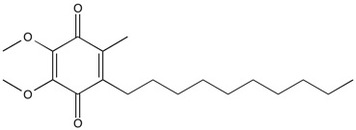Decylubiquinone | MPTP inhibitor
NMR (Conforms)

Available Options
| Size : | Price | Quantity | |
|---|---|---|---|
| 10 mg | $55.00 | ||
| 50 mg | $220.00 |
Decylubiquinone (55486-00-5) inhibits the Ca2+ dependent mitochondrial permeability transition pore (MPTP) without inhibiting respiration.1 Maximum effect on Ca2+ retention capacity of rat liver mitochondria at 100 μM. Inhibits etoposide-induced apoptosis in in L929 cells at 5 μM via inhibition of cytochrome C release.2 Delays rotenone-induced cardiac dysfunction in a zebrafish model of development and cardiovascular function.3 Substrate for various quinone oxidoreductases.4,5
References/Citations:
1) Fontaine et al. (1998), A Ubiquinone-binding Site Regulates the Mitochondrial Permeability Transition Pore; J. Biol. Chem., 273 25734
2) Karpinich et al. (2002), The course of Etoposide-Induced Apoptosis from Damage to DNA and p53 Activation to Mitochondrial Release of Cytochrome c; J. Biol. Chem., 277 16547
3) Pinho et al. (2013) How mitochondrial dysfunction affects zebrafish development and cardiovascular function: an in vivo model for testing mitochondria-targeted drugs; Br. J. Pharmacol., 169 1072
4) Kunow et al. (1994) F420H2: quinone oxidoreductase from Archaeoglobus fulgidus. Characterization of a membrane-bound multisubunit complex containing FAD and iron-sulfur clusters; Eur. J. Biochem., 223 503
5) Zickermann et al (1998) Analysis of the pathogenic human mitochondria mutation ND1/3460 and mutations of strictly conserved residues in it’s vicinity, using the bacterium Paracoccis denitrificans; Biochemistry, 37 11792
NMR (Conforms)
Safety Data Sheet:
Product Data Sheet:
Materials provided by Focus Biomolecules are for laboratory research use only and are not intended for human or veterinary applications. Please note that we do not sell to individuals and that all orders placed by non-research organizations will incur a $20 restocking/refund fee
Decylubiquinone (55486-00-5) inhibits the Ca2+ dependent mitochondrial permeability transition pore (MPTP) without inhibiting respiration.1 Maximum effect on Ca2+ retention capacity of rat liver mitochondria at 100 μM. Inhibits etoposide-induced apoptosis in in L929 cells at 5 μM via inhibition of cytochrome C release.2 Delays rotenone-induced cardiac dysfunction in a zebrafish model of development and cardiovascular function.3 Substrate for various quinone oxidoreductases.4,5
References/Citations:
1) Fontaine et al. (1998), A Ubiquinone-binding Site Regulates the Mitochondrial Permeability Transition Pore; J. Biol. Chem., 273 25734
2) Karpinich et al. (2002), The course of Etoposide-Induced Apoptosis from Damage to DNA and p53 Activation to Mitochondrial Release of Cytochrome c; J. Biol. Chem., 277 16547
3) Pinho et al. (2013) How mitochondrial dysfunction affects zebrafish development and cardiovascular function: an in vivo model for testing mitochondria-targeted drugs; Br. J. Pharmacol., 169 1072
4) Kunow et al. (1994) F420H2: quinone oxidoreductase from Archaeoglobus fulgidus. Characterization of a membrane-bound multisubunit complex containing FAD and iron-sulfur clusters; Eur. J. Biochem., 223 503
5) Zickermann et al (1998) Analysis of the pathogenic human mitochondria mutation ND1/3460 and mutations of strictly conserved residues in it’s vicinity, using the bacterium Paracoccis denitrificans; Biochemistry, 37 11792
Calculate the molar concentration, mass or volume in a solution.
Concentration × Volume × Molecular Weight = Mass
Focus Biomolecules • Plymouth Meeting, PA USA • 1-855-FOCUS21
Focus Biomolecules
Plymouth Meeting, PA USA
1-855-FOCUS21
Website Created by Advanta Advertising LLC.

